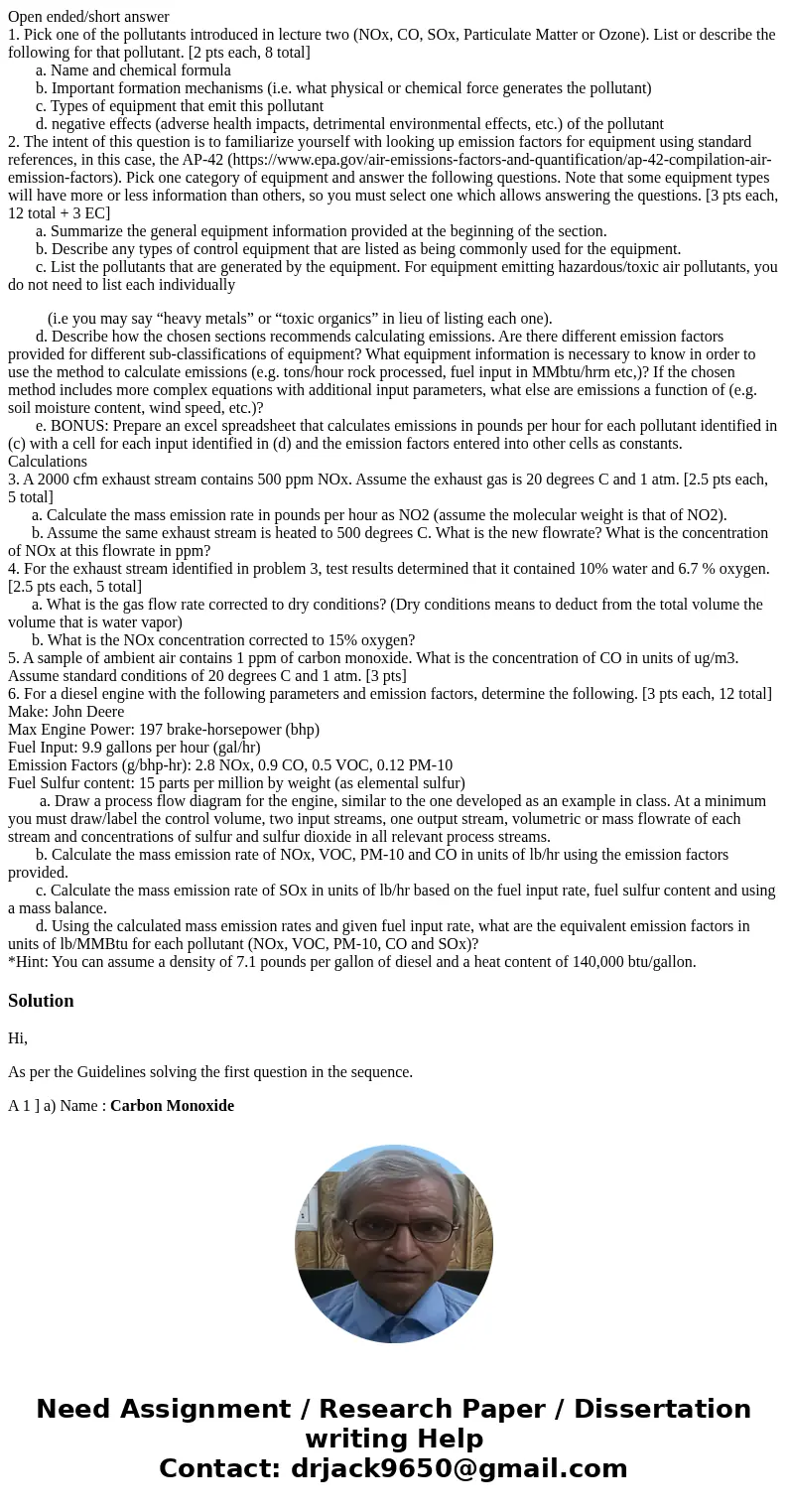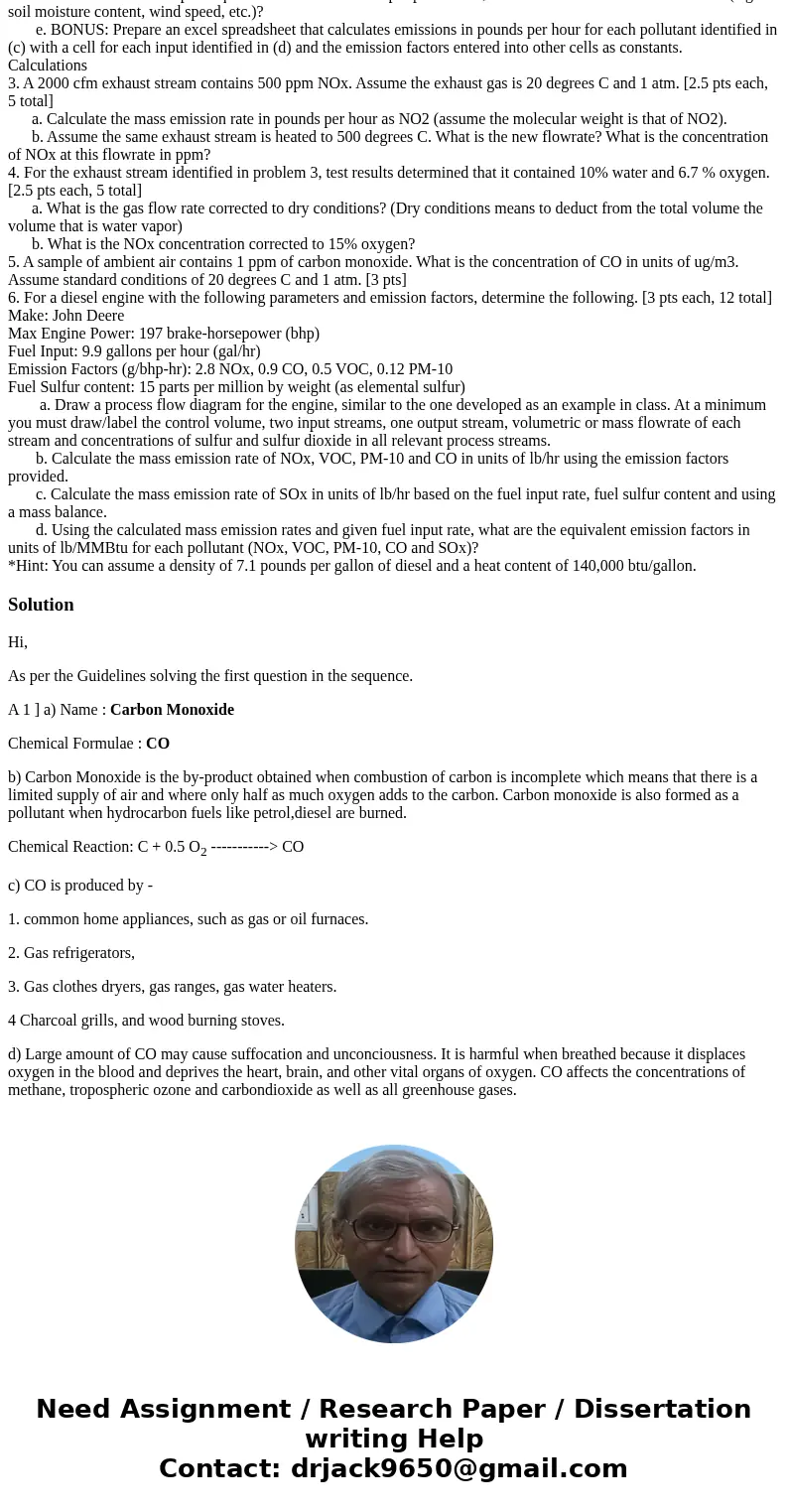Open endedshort answer 1 Pick one of the pollutants introduc
Open ended/short answer
1. Pick one of the pollutants introduced in lecture two (NOx, CO, SOx, Particulate Matter or Ozone). List or describe the following for that pollutant. [2 pts each, 8 total]
a. Name and chemical formula
b. Important formation mechanisms (i.e. what physical or chemical force generates the pollutant)
c. Types of equipment that emit this pollutant
d. negative effects (adverse health impacts, detrimental environmental effects, etc.) of the pollutant
2. The intent of this question is to familiarize yourself with looking up emission factors for equipment using standard references, in this case, the AP-42 (https://www.epa.gov/air-emissions-factors-and-quantification/ap-42-compilation-air-emission-factors). Pick one category of equipment and answer the following questions. Note that some equipment types will have more or less information than others, so you must select one which allows answering the questions. [3 pts each, 12 total + 3 EC]
a. Summarize the general equipment information provided at the beginning of the section.
b. Describe any types of control equipment that are listed as being commonly used for the equipment.
c. List the pollutants that are generated by the equipment. For equipment emitting hazardous/toxic air pollutants, you do not need to list each individually
(i.e you may say “heavy metals” or “toxic organics” in lieu of listing each one).
d. Describe how the chosen sections recommends calculating emissions. Are there different emission factors provided for different sub-classifications of equipment? What equipment information is necessary to know in order to use the method to calculate emissions (e.g. tons/hour rock processed, fuel input in MMbtu/hrm etc,)? If the chosen method includes more complex equations with additional input parameters, what else are emissions a function of (e.g. soil moisture content, wind speed, etc.)?
e. BONUS: Prepare an excel spreadsheet that calculates emissions in pounds per hour for each pollutant identified in (c) with a cell for each input identified in (d) and the emission factors entered into other cells as constants.
Calculations
3. A 2000 cfm exhaust stream contains 500 ppm NOx. Assume the exhaust gas is 20 degrees C and 1 atm. [2.5 pts each, 5 total]
a. Calculate the mass emission rate in pounds per hour as NO2 (assume the molecular weight is that of NO2).
b. Assume the same exhaust stream is heated to 500 degrees C. What is the new flowrate? What is the concentration of NOx at this flowrate in ppm?
4. For the exhaust stream identified in problem 3, test results determined that it contained 10% water and 6.7 % oxygen. [2.5 pts each, 5 total]
a. What is the gas flow rate corrected to dry conditions? (Dry conditions means to deduct from the total volume the volume that is water vapor)
b. What is the NOx concentration corrected to 15% oxygen?
5. A sample of ambient air contains 1 ppm of carbon monoxide. What is the concentration of CO in units of ug/m3. Assume standard conditions of 20 degrees C and 1 atm. [3 pts]
6. For a diesel engine with the following parameters and emission factors, determine the following. [3 pts each, 12 total]
Make: John Deere
Max Engine Power: 197 brake-horsepower (bhp)
Fuel Input: 9.9 gallons per hour (gal/hr)
Emission Factors (g/bhp-hr): 2.8 NOx, 0.9 CO, 0.5 VOC, 0.12 PM-10
Fuel Sulfur content: 15 parts per million by weight (as elemental sulfur)
a. Draw a process flow diagram for the engine, similar to the one developed as an example in class. At a minimum you must draw/label the control volume, two input streams, one output stream, volumetric or mass flowrate of each stream and concentrations of sulfur and sulfur dioxide in all relevant process streams.
b. Calculate the mass emission rate of NOx, VOC, PM-10 and CO in units of lb/hr using the emission factors provided.
c. Calculate the mass emission rate of SOx in units of lb/hr based on the fuel input rate, fuel sulfur content and using a mass balance.
d. Using the calculated mass emission rates and given fuel input rate, what are the equivalent emission factors in units of lb/MMBtu for each pollutant (NOx, VOC, PM-10, CO and SOx)?
*Hint: You can assume a density of 7.1 pounds per gallon of diesel and a heat content of 140,000 btu/gallon.
Solution
Hi,
As per the Guidelines solving the first question in the sequence.
A 1 ] a) Name : Carbon Monoxide
Chemical Formulae : CO
b) Carbon Monoxide is the by-product obtained when combustion of carbon is incomplete which means that there is a limited supply of air and where only half as much oxygen adds to the carbon. Carbon monoxide is also formed as a pollutant when hydrocarbon fuels like petrol,diesel are burned.
Chemical Reaction: C + 0.5 O2 -----------> CO
c) CO is produced by -
1. common home appliances, such as gas or oil furnaces.
2. Gas refrigerators,
3. Gas clothes dryers, gas ranges, gas water heaters.
4 Charcoal grills, and wood burning stoves.
d) Large amount of CO may cause suffocation and unconciousness. It is harmful when breathed because it displaces oxygen in the blood and deprives the heart, brain, and other vital organs of oxygen. CO affects the concentrations of methane, tropospheric ozone and carbondioxide as well as all greenhouse gases.


 Homework Sourse
Homework Sourse